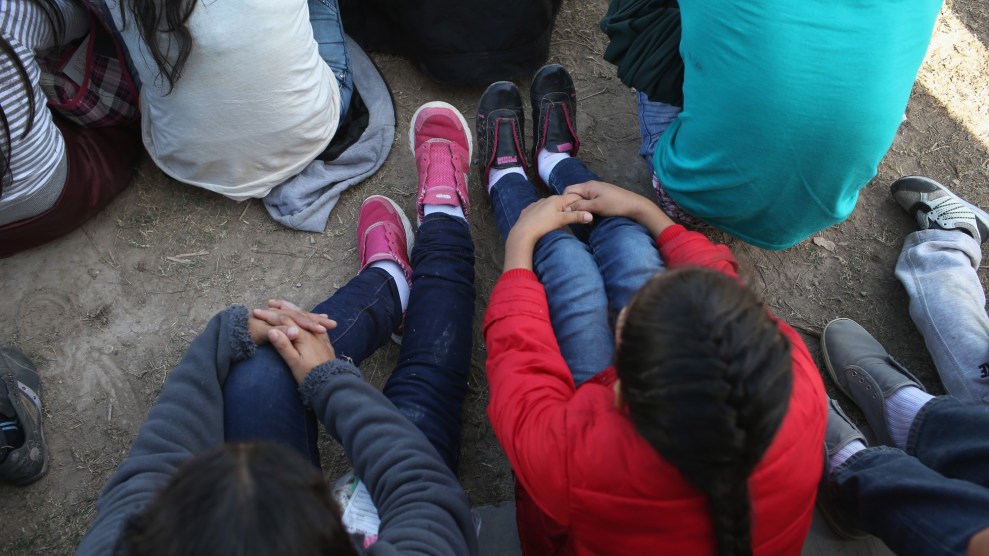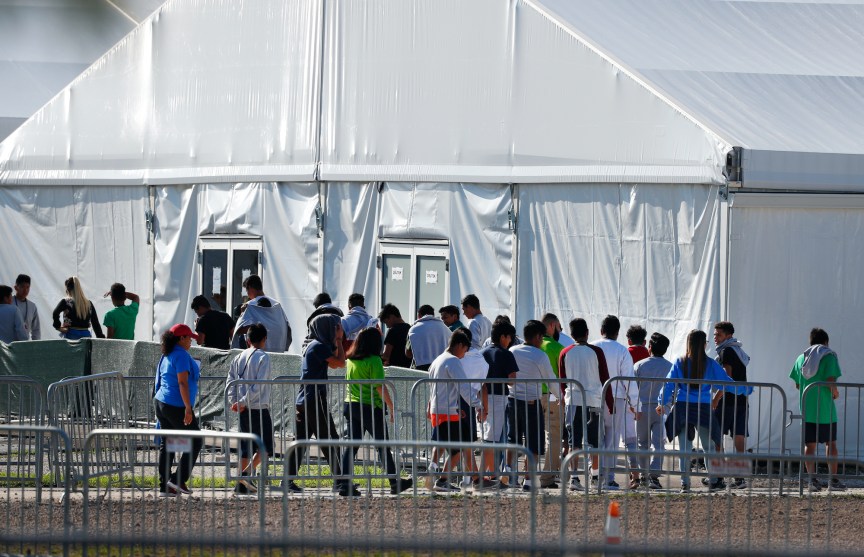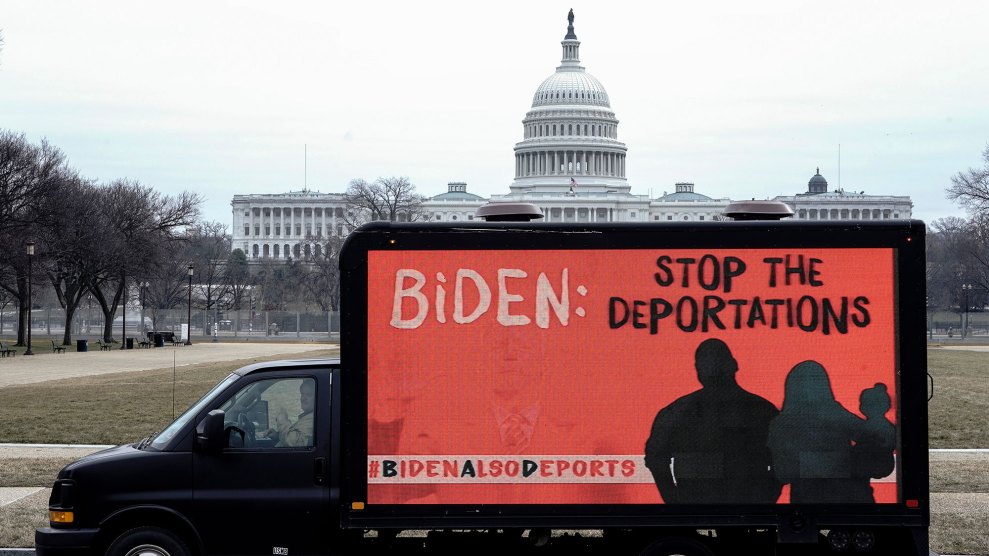
Central American migrants near Rio Grande City, Texas on December 8, 2015.John Moore/Getty
In his first testimony before a House committee since being confirmed in early February, Department of Homeland Secretary Alejandro Mayorkas said on Wednesday that the agency is responding to “historic and unprecedented challenges at the border,” where the number of migrants arriving is on pace to reach a 20-year high. Most migrants, Mayorkas explained, are single adults and families who are being expelled under a Trump-era public health measure known as Title 42 that effectively closed the border for asylum seekers. President Joe Biden has kept the order in place, except for unaccompanied minors.
The number of children and teens coming to the United States Southern border shot up by more than 60 percent in February compared to the previous month. On average, 500 children and teens arrive each day. About 4,200 minors are being held in Customs and Border Protection facilities—more than half of them remain there for longer than the 72-hour limit—while many more are housed in shelters across the country while waiting to be reunited with a family member or legal guardian.
In recent weeks, the Biden administration has reopened a temporary facility for migrant children in Texas that closed after a month of operations in 2019 following a drop in apprehensions at the border. The administration reportedly also has considered bringing back another controversial emergency shelter in Florida located next to a Superfund site, which advocates have said could pose health risks to the children. Plans to house unaccompanied minors in a convention center in Dallas are underway, and a NASA site in California is also being considered. Last week, Mayorkas announced an order directing the Federal Emergency Management Agency (FEMA) to help “safely receive, shelter, and transfer unaccompanied children who make the dangerous journey to the U.S. southwest border” over a 90-day period.
During Wednesday’s hearing, Republicans repeatedly pressed Mayorkas to acknowledge that what is taking place at the border is not just a challenge but a crisis. “I will share with you how I define a crisis,” he said. “A crisis is when a nation is willing to rip a 9-year-old child out of the hands of his or her parent and separate that family to deter future migration. That, to me, is a humanitarian crisis.”
No matter how the current situation at the border is characterized, it does require some context. Mother Jones asked international human rights lawyer and expert on child migration in the United States Jennifer Podkul, who is also vice president for policy and advocacy at the national organization Kids in Need of Defense (KIND), to help us break through the noise. She explained the broader context and what we need to know about the children and teens arriving alone at the border to seek protection in the US.
The US is potentially looking at a 20-year high in the number of migrants arriving at the Southern border, including thousands of unaccompanied minors. Can you help put that number in context?
If what’s projected comes true, and there really are going to be more than 100,000 unaccompanied children who ask for protection at the US border, that would be the highest number ever. But it’s not surprising at all, and there are a few reasons. First, in 2020, unaccompanied children were told that they were not allowed to ask for protection in the US, and if they ever tried to, they were dumped in Mexico. There was this artificial backlog of children who had been waiting in Northern Mexico. We knew that when Title 42 was repealed for kids, whether through a court process or a new administration, there would be a pressure valve that needed to be released.
For several years now, there have been high numbers of kids, predominantly from Guatemala, Honduras, and El Salvador, who have felt like they had to flee because they did not feel safe, and they did not feel like their governments could protect them. Now, those conditions still exist, but you also have all the damage that was caused by the hurricane and the pandemic that have devastated those countries. There’s even less protection for kids right now. From our perspective, the numbers are troubling—because they signal significant problems in Central America—but they’re not unexpected. You can see in the annual statistics on the Customs and Border Protection website that migration has seasonal trends. What we’re seeing now, although the numbers are high, is absolutely in line with the seasonal migration flows that we’ve seen in the past.
How is what is happening now any different from other points in time when there were large numbers of unaccompanied minors arriving at the border, like in 2014 and then in 2019?
2014 was the first year when the number jumped dramatically from the year before and the Obama administration was surprised by it. They did not expect that number of children, which is why we saw the Obama administration relying on influx facilities, because they didn’t have enough state-licensed facilities to care for the children while they were looking for their sponsors. In 2019, the Trump administration also relied on influx facilities, but the reasoning was different. It was not because there were unexpected arrivals. First, the administration “created” unaccompanied children by separating them from their parents during the zero-tolerance policy. They also put in place restrictive policies that made it harder for kids to get out of government custody. The Biden administration decided they’re going to comply with the law and allow unaccompanied children to present themselves, and they’re dealing with the repercussions of the harm that was caused by the previous administration.
What do we know about the arriving unaccompanied minors?
The ages, gender, and countries of origin statistics have stayed pretty consistent since 2014. It’s mostly Honduran, Salvadoran, and Guatemalan children. It tends to skew a little bit more boys than girls and, generally, the kids are a little older. Having said that, there are still very young unaccompanied children. Just a few weeks ago, KIND worked with three siblings who are under 10. In terms of what we know about who they’re coming with and how they’re coming, it really varies. Some kids may be traveling with extended family members, and not necessarily a parent or legal guardian, but aunt, uncle, cousin. I’ve spoken to very young kids who traveled in groups for safety in some parts, stopping and working so that they could earn a little bit of money to complete their journey. Some kids really are making it on their own.
What we’ve been very concerned about, and what we’ve been seeing over the past few years, both with the Migrant Protection Protocols that kept asylum seekers in Mexico and also Title 42, is that a lot of children and family members were victims of criminal entities in Northern Mexico. For example, those young siblings I just met, their mother was killed when they were in Mexico, so they were orphaned. We’ve certainly had children whose parents were disappeared or were victims of crimes, and that’s why the children felt like they had to present alone. But remember, a child who’s with an extended family member who is not their parent or legal guardian is still legally unaccompanied. That’s the legal definition.
There have been reports that unaccompanied minors are being held in border facilities for more than 100 hours. Why are they staying longer than they should?
Different agencies have different responsibilities when it comes to unaccompanied kids. The entity that a child would encounter when they present at the border, whether they walk up to a bridge or they are apprehended by border patrol, is Customs and Border Protection. CBP has these secondary holding facilities designed to hold people for a very short amount of time because they don’t have any minimum standards. Congress has said CBP can’t keep these kids for longer than 72 hours and their responsibility is to decide if a child meets that legal definition of unaccompanied minor. If they do, it’s immediately the responsibility of the Department of Health and Human Services to provide care and custody while the government looks for a sponsor for them in the US. HHS has hundreds of facilities around the country that are licensed by the state and have different programs like long-term foster care, group homes, bigger shelters. What’s happening right now is the encounter rates of children are higher than what HHS is able to accommodate. So they’ve opened the Carrizo [Springs] influx facility to accommodate more children, and they’re opening two “decompression” sites so that they can have children move into a place where they’re being cared for by child welfare experts and not by border patrol agents. We’re seeing kids having to wait very long periods of time in border patrol stations and certainly much longer than the 72 hours allowed by Congress.
Part of the issue with the number of beds at HHS facilities also has to do with the pandemic, right?
HHS has at least 13,000 beds available around the country. In fact, they actually were criticized last year for maintaining so many beds when there were only about 700 kids in government custody. But everyone anticipated that there were going to be high numbers because of the built-up demand. When COVID hit they weren’t able to use every single bed because there were social distancing protocols. So for a while, they had dramatically reduced capacity. Even though there were empty beds around the country in these licensed facilities, they couldn’t use them all.
Is there any truth in saying that children are still being kept in cages?
That’s a great question. The cages were actually an old CBP facility with these little cells where they kept kids and families, and that was the spot at the heart of family separation. That facility actually was taken down at the end of the Trump administration. The standards are abysmal in the CBP facilities. Some of the smaller ones have been referred to as ice boxes. The ORR [Office of Refugee Resettlement, a branch of HHS] facilities are different: they have to meet minimum standards and are reviewed by state licensors. Some are better than others, but there are none that looked like those cages.
Anytime a child is in government custody there has to be the highest of standards and absolute transparency and accountability. The concern with the influx facilities is that they’re not licensed by the state, so you’ve lost one of your checks. Domestic child welfare has moved away from relying on large congregate care for children and has said it’s more appropriate to house children in smaller facilities. There are a lot of people who are concerned that these influx facilities are just way too big to adequately provide quality services and good protection for children. The government has put some guardrails in how they use them, making sure that very young children and indigenous language speakers never go into those facilities because they have less services than the state-licensed ones. The other important thing is how long kids spend there. The Obama administration only put kids in those facilities who had a sponsor likely to get the child very quickly, so kids spent between 10 and 14 days [in those places]. The Trump administration used them as a substitute for regular licensed facilities, so children stayed there for months, which was totally inappropriate. We certainly don’t think these influx and “decompression” facilities are good for kids. We certainly don’t want to see kids piled up in border patrol stations. But I can also say, I’ve been to those camps in northern Mexico, and they are so dangerous, it’s better for children not to be there.
What is the Biden administration doing to expedite the process of placing children in the care of a sponsor?
KIND made recommendations to the Biden transition team to ensure that ORR goes back to being a child welfare agency and not co-opted into a law enforcement agency. One of the first things the administration did was to dismantle the agreement between DHS and HHS to share information about adults who apply to be sponsors for enforcement purposes. [The agreement] had an absolute chilling effect on people being willing to come forward to take care of the children, who oftentimes languished in these facilities needlessly. They have also allowed [shelter operators] to pay for the flight of the child to be reunited with the sponsor, if coming up with the money was causing the delay. Their reunification caseworkers are working around the clock. There are a few things they could still do, such as making sure that HHS staff are co-located in the CBP facilities. That way you have child welfare experts who are there to do the screening, and you’re not wasting 10 days to start working on the reunification, while that kid sits in a border patrol facility.
They absolutely should be sure to have have people checking on that kid after they’ve been reunified through post-release social and legal services. Once the child goes to a sponsor, their legal journey is only just beginning. They have to go through the whole court process and defend themselves against deportation. It’s next to impossible to imagine that they could do that without a lawyer.
What are advocates most concerned about? What should be the top priorities?
The administration needs to be working on two tracks. In the short term, they have to get those kids out of border patrol stations and into loving homes as quickly as possible. Simultaneously, they have to prioritize reimagining the system. Is the reception of migrant children the way it really should be, or could the US do better? We saw this happen in 2014. We saw this happen in 2019. We’re seeing it now. We’re going to be here again unless there’s real systematic change. You have an administration that has the will to do it. But they have to be doing that at the same time that they’re addressing the crushing need right now at the border. It’s difficult, but it’s certainly going to be worth it for the kids, but also for our government.
What Biden did was say: It’s going to be difficult, but I’m going to do it right by the law. I’m going to stop expelling unaccompanied kids. That’s the humane thing to do. In that sense, did he create the situation? Sure. But I think that was the right thing to do.
What do you think we’ve learned or should have learned by now?
It’s a good question. I think what we have learned is that Americans care very much about these kids, especially after the trauma of family separation. In 2014, there were a lot of people who didn’t quite know who these kids were, where they were coming from, why they were coming here, what was the United States’ responsibility to them. I think we’re at a very different moment. We saw kids held for long periods of time in government custody under the Trump administration. We saw babies separated from their mothers. There’s this real understanding and compassion for this population now, which I feel we have not had before. That presents an opportunity and a lot of political will for things to be reimagined. The risk is, if we don’t, we’re going to stay in this cycle over and over again because it’s going to take a long time for the conditions in Central America to resolve. The administration’s commitment to making significant investments in the region in the long term will pay off, so that children can stay at home, and they never feel the need to flee in the first place.
















